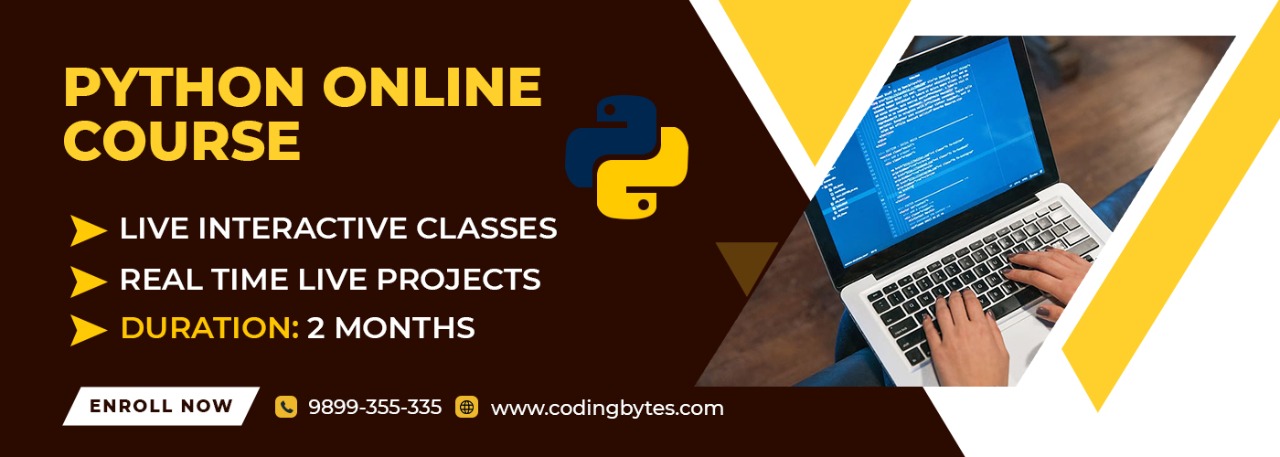
Python Online Certification Course in Delhi
Learn the most in-demand Python certification course that will help you gain skills in writing Python code and working with packages, such as SciPy, Matplotlib, Pandas, Scikit-Learn, NumPy, web scraping libraries, and the Lambda function.
➡ Online Python Course Fees: Rs. 11999/-
➡ Online Python Course Duration: 2 months
➡ Weekend & Weekdays Batches Available
Request a Call Back!
Python Online Certification Course
Course Highlights
- Python Environment Setup and Essentials
- Python language Basic Constructs
- OOPs concepts in Python
- Database connection
- NumPy for mathematical computing
- SciPy for scientific computing
- Matplotlib for data visualization
- Pandas for data analysis and machine learning
- Exception Handling
- Multi Threading & Race Condition
- Packages and Functions
- Web scraping with Python
Python Course Details
Module 01 – Python Environment Setup and Essentials
1.1 Introduction to Python Language
1.2 Features, the advantages of Python over other programming languages
1.3 Python installation: Windows, Mac & Linux distribution for Anaconda Python
1.4 Deploying Python IDE
1.5 Basic Python commands, data types, variables, keywords and more
Hands-on Exercise: Installing Python Anaconda for the Windows, Linux and Mac.
Module 02 – Python language Basic Constructs
2.1 Built-in data types in Python
2.2 Learn classes, modules, Str(String), Ellipsis Object, Null Object, Ellipsis, Debug
2.3 Basic operators, comparison, arithmetic, slicing and slice operator, logical, bitwise
2.4 Loop and control statements while, for, if, break, else, continue.
Hands-on Exercise:
1. Write your first Python program
2. Write a Python Function (with and without parameters)
3. Use Lambda expression
4. Write a class
5. Create a member function and a variable
6. create an object
7. Write a for loop
Blank
Module 03 - OOP concepts in Python
3.1 How to write OOP concepts program in Python
3.2 Connecting to a database
3.3 Classes and objects in Python
3.4 OOPs paradigm, important concepts in OOP like polymorphism, inheritance, encapsulation
3.5 Python functions, return types and parameters
3.6 Lambda expressions
Hands-on Exercise:
1. Creating an application which helps to check balance, deposit money and withdraw the money using the concepts of OOPS.
Module 04 - Database connection
4.1 Understanding the Database, need of database
4.2 Installing MySQL on windows
4.3 Understanding Database connection using Python.
Hands-on Exercise: Demo on Database Connection using python and pulling the data.
Module 05 - NumPy for mathematical computing
5.1 Introduction to arrays and matrices
5.2 Broadcasting of array math, indexing of array
5.3 Standard deviation, conditional probability, correlation and covariance.
Hands-on Exercise:
1. How to import NumPy module
2. Creating array using ND-array
3. Calculating standard deviation on array of numbers
4. Calculating correlation between two variables.
Module 06 - SciPy for scientific computing
6.1 Introduction to SciPy
6.2 Functions building on top of NumPy, cluster, linalg, signal, optimize, integrate, subpackages, SciPy with Bayes Theorem.
Hands-on Exercise:
1. Importing of SciPy
2. Applying the Bayes theorem on the given dataset.
Module 07 - Matplotlib for data visualization
7.1 How to plot graph and chart with Python
7.2 Various aspects of line, scatter, bar, histogram, 3D, the API of MatPlotLib, subplots.
Hands-on Exercise:
1. Deploying MatPlotLib for creating Pie, Scatter, Line, Histogram.
Module 08 - Pandas for data analysis and machine learning
8.1 Introduction to Python dataframes
8.2 Importing data from JSON, CSV, Excel, SQL database, NumPy array to dataframe
8.3 Various data operations like selecting, filtering, sorting, viewing, joining, combining
Hands-on Exercise:
1. Working on importing data from JSON files
2. Selecting record by a group
3. Applying filter on top, viewing records
Module 09 - Exception Handling
9.1 Introduction to Exception Handling
9.2 Scenarios in Exception Handling with its execution
9.3 Arithmetic exception
9.4 RAISE of Exception
9.5 What is Random List, running a Random list on Jupyter Notebook
9.6 Value Error in Exception Handling.
Hands-on Exercise:
1. Demo on Exception Handling with an Industry-based Use Case.
Module 10 - Multi Threading & Race Condition
10.1 Introduction to Thread, need of threads
10.2 What are thread functions
10.3 Performing various operations on thread like joining a thread, starting a thread, enumeration in a thread
10.4 Creating a Multithread, finishing the multithreads.
10.5 Understanding Race Condition, lock and Synchronization.
Hands-on Exercise:
1. Demo on Starting a Thread and a Multithread and then perform multiple operations on them.
Module 11 - Packages and Functions
11.1 Intro to modules in Python, need of modules
11.2 How to import modules in python
11.3 Locating a module, namespace and scoping
11.4 Arithmetic operations on Modules using a function
11.5 Intro to Search path, Global and local functions, filter functions
11.6 Python Packages, import in packages, various ways of accessing the packages
11.7 Decorators, Pointer assignments, and Xldr.
Hands-on Exercise:
1. Demo on Importing the modules and performing various operation on them using arithmetic functions
2. Importing various packages and accessing them and then performing different operations on them.
Module 12 - Web scraping with Python
12.1 Introduction to web scraping in Python
12.2 Installing of beautifulsoup
12.3 Installing Python parser lxml
12.4 Various web scraping libraries, beautifulsoup, Scrapy Python packages
12.5 Creating soup object with input HTML
12.6 Searching of tree, full or partial parsing, output print
Hands-on Exercise:
1. Installation of Beautiful soup and lxml Python parser
2. Making a soup object with input HTML file
3. Navigating using Py objects in soup tree.
